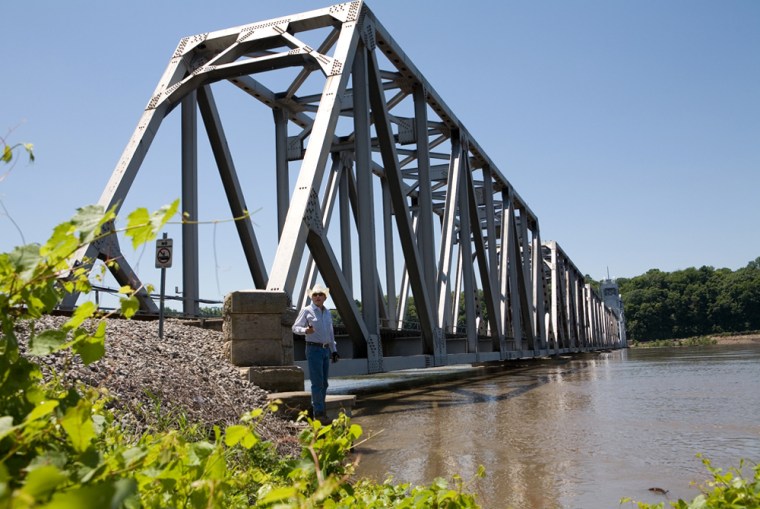In a move that local officials say threatens hundreds of homes and tens of thousands of acres of crops, the Norfolk Southern Railroad has refused to raise a bridge that residents fear could create a giant logjam on the Mississippi River and send floodwaters pouring over a fragile levee.
The townspeople in this Illinois farm community across the river from the Missouri town made famous by Mark Twain say the railroad quietly reneged on a promise to keep the bridge up during this week’s expected record river crest and then removed electric motors so it cannot be lifted until the water recedes. Adding to their sense of betrayal is the knowledge that the bridge’s lift span was rebuilt 15 years ago with federal tax dollars.
A spokesman for Norfolk Southern said the railroad made no such promise and that the U.S. Coast Guard “did not object” to its plans.
The anxiety gripping this community is being felt for hundreds of miles along the Upper Mississippi this week. At least three levees have failed elsewhere along the river as the river rises toward record levels.
“It’s just not right,” said a frustrated and angry Russ Koeller, a commissioner with the Sny Island Levee Drainage District, as he led a reporter out onto the bridge Tuesday afternoon. “The railroad agreed to cooperate to minimize risk” by raising the bridge, “and they reneged. I haven’t used the word ‘lied,’ but they reneged and that’s not right.”
Bridge may act as debris catcher
Standing a few feet above the roiling muddy water as the pungent smell of creosote wafted off the sun-baked railroad ties, it was easy to understand Koeller’s fear.

When the water goes up another four feet to its predicted crest of 31.8 feet late this week, it will slam against the superstructure of the bridge — a series of cantilevered spans that run about 1,000 feet from here to Hannibal on the Missouri side. That will effectively create a dam that will catch logs, propane tanks, wrecked boats and any other debris that comes downriver, which could push the water higher behind the blockage.
The slightest rise in the river’s level could mean the difference between the levee riding it out or failing, said Koeller, 62.
Rudy Husband, the railroad’s spokesman on Northeast and Midwest affairs, denied that the company had promised to leave the lift section of the span up, allowing a clearer path for water and debris.
He said company engineers decided the bridge is “more stable in the down position than the up position,” so “last Friday, after consulting with both the Coast Guard and the U.S. Army Corps of Engineers, we put that bridge in the closed (down) position and locked it.”
Husband said that keeping a lift bridge in place “is fairly standard procedure” in the event of flooding, and he said that a member of the Army Corps of Engineers told the railroad that the bridge’s position would likely have no effect on water levels.
He later acknowledged, however, that the railroad had not talked to anyone at the corps about closing the bridge until Monday, after it had been done and when it was too late to reverse the decision.
Husband also said that the Coast Guard “knew what we were doing. They didn’t object.”
Company didn't need to ask permission
Roger Wiebusch, the Coast Guard’s bridge administrator for the Mississippi River, said “Norfolk Southern did not ask us” for permission to keep the bridge down, which the company does not need under law. He said that the service also was informed of the decision after the fact. “They told us they were keeping it down and had removed the motor,” he said.
Andy Rowe, an aide to Rep. Phil Hare, D.-Ill., who has been looking into the matter, confirmed that after the decision was made, “No one thought to get in touch with the levee district.”
Koeller and fellow levee board member Dan Lundberg, 60, said their concern about the bridge is not theoretical. They and scores of other residents of the district’s Reach 1 were devastated when the bridge wasn’t raised in 1993, which they said triggered a breach in the levee that flooded homes and farm buildings and destroyed crops planted in 42,000 acres of some of the nation’s richest farmland.
“That’s what blew it out last time,” said Koeller.
“I had 16 feet of water in my house,” Lundberg said. “It was bad.” Like many other area residents, he said, he had to take a job off the farm for a time to make ends meet.
Koeller and Lundberg, lifelong Illinois residents and farmers with 6,600 acres under plow between their two families, said they didn’t blame the railroad at the time because the old swing-span bridge was being replaced with the lift span and couldn’t have been easily moved.
Wiebusch of the Coast Guard confirmed that the bridge was being replaced for navigational safety reasons at the time, courtesy of federal funding.
‘We learn from our mistakes’
“But we learn from our mistakes,” Koeller said. So with the Mississippi on the rise this month, the levee district reviewed how it needed to prepare. Getting the bridge raised was “on the checkbox list of things we had to prepare for, and we thought we had that one checked off,” Koeller said.
With their $1 million annual operating budget for the 55 miles of levee that the Sny Island district maintains already stressed beyond busting by rising fuel costs this year, levee district members said they feel a bit like David battling Norfolk Southern’s Goliath, a 39,000-employee public corporation that is listed on the New York Stock Exchange. The railroad runs trains on 21,000 miles of track across 22 states and generated revenue from rail operations last year of nearly $9.5 billion.
But “they don’t even look after their own best interests,” Koeller said of Norfolk Southern, noting that a levee breach could potentially damage the miles of the railroad’s tracks that are protected by the district’s levee.
Another congressman, Rep. Kenny Hulshof, a Republican who represents much of northeast Missouri, said that once the water recedes, he'll look into exactly what promises were made and by whom. “It certainly appears that the decision to keep the bridge down was made without sufficient thought being given to other factors, namely what impact the action might have on flood control,” Hulshof said in a statement provided to msnbc.com.
The outcome leaves Koeller shaking his head and warily eyeing the water creeping up the black plastic sheeting that crews are draping over the levees 24/7 now. He said he wouldn't worry quite so much if the bridge were up and letting as much water through as possible, because the river’s crest is expected to come perilously close to the top of the levee anyway.
“In the end we’re just talking about inches,” he said.
